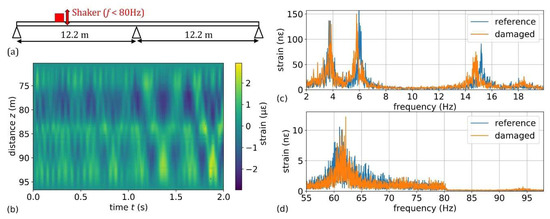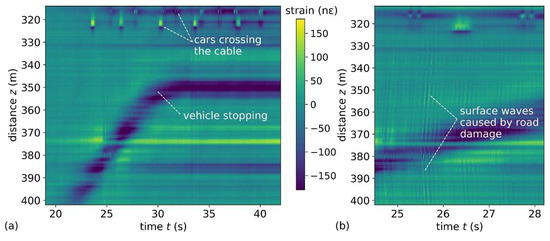Abstract
We introduce wavelength-scanning coherent optical time domain reflectometry (WS-COTDR) for dynamic vibration sensing along optical fibers. The method is based on spectral shift computation from Rayleigh backscatter spectra. Artificial neural networks (ANNs) are used for fast and high-resolution strain computation from raw measurement data. The applicability of the method is demonstrated for vibration monitoring of a reinforced concrete bridge. We demonstrate another application example for quasi-static and dynamic measurement of ground deformation and surface wave propagation along a dark fiber in a telecommunication cable.
1. Introduction
The progress of optical fiber sensors for distributed measurement has been very dynamic in recent years. The performance improvement is particularly rapid for dynamic strain sensing, often referred to as distributed acoustic sensing (DAS). Most DAS approaches are based on Rayleigh scattering and coherent optical time domain reflectometry [1,2]. Spatial resolutions in the meter-range can be measured with nε (nm/m) sensitivity over distances up to tens of kilometers.
Early adopter of DAS was the oil and gas industry, using DAS for seismic exploration and integrity monitoring [3]. As the technology matures and is becoming more widely available, the range of applications for DAS is broadening significantly: More and more applications can be found in the structural health monitoring sector, for traffic and rail monitoring, power line monitoring, as well as for a range of seismic applications.
Most pulse DAS principles are based on optical phase demodulation and phase change tracking. We recently proposed a DAS approach based on wavelength-scanning coherent optical time domain reflectometry (WS-COTDR) [4]. Hereby, the fiber is rapidly scanned by periodic pulse sequences with increasing optical frequency of each pulse in the sequence. Each new “wavelength scan” is compared to a reference scan to calculate the strain change distribution along the fiber under test (FUT). The advantage of the WS-COTDR technique is that new measurements can be compared to a permanent and unambiguous reference. In contrast to phase-tracking DAS approaches, interrupted measurements can be resumed, and strain changes can be computed relative to any recorded reference scan.
This paper is structured as following: The WS-COTDR technique is briefly introduced in Section 2.1, and the strain computation approach using ANNs is summarized in Section 2.2. Measurement results are shown for the application examples of strain monitoring of a bridge model (Section 3.1) and for distributed ground movement measurement along a “dark” telecommunication fiber (Section 3.2).
2. Methods
2.1. Wavelength-Scanning COTDR
The WS-COTDR approach and experimental implementation has been described in detail in [4]. Figure 1a shows the basic experimental setup. Coherent optical pulses are shaped from the continuous-wave input of a low-cost DFB laser source by a semiconductor optical amplifier (SOA), and are sent into the FUT with a constant pulse repetition rate fp. At the same time, the optical frequency ν of the laser is periodically tuned by means of direct laser current modulation with a triangular “frequency sweep” signal with the sweep rate fs. The relation fp/fs is typically between 20 and 100. The fiber’s Rayleigh backscatter trace is therefore periodically sampled for a range of pulse optical frequencies. We make use of the proportionality of the spectral shift of the sampled backscatter signature and strain or temperature changes [5,6]: By computing the shift of the Rayleigh power spectrum for each new frequency sweep relative to a reference sweep result for each distance sampling position, a distributed strain change measurement can be performed (see Figure 1b).

Figure 1.
(a) Schematic of the WS-COTDR setup (EDFA – Erbium-doped fiber amplifier). (b) Measured raw data sweep results (Rayleigh backscattering power) for a single distance sample z = 72.8 m, from measurement shown in Figure 2a. (fs = 1 kHz, fp = 200 kHz, 1 m spatial resolution).
Compared to pulse-to-pulse evaluation of phase-resolved DAS approaches, the maximum repetition rate is reduced by the relation fp/fs. The current practical lower limit is fp/fs ≈ 20. This translates, for example, to 1 kHz repetition rate up to 5.1 km distance range. However, extended distance ranges > 70 km at lower repetition rates are also feasible with this approach.
2.2. Artificial Neural Networks (ANNs) for Strain Computation
So far, the strain change has been computed using a least mean square (LMS) correlation approach and subsequent interpolation of the correlation result [4]. This way, strain noise of 0.23 nε/√Hz was achieved over 1 km distance at fs = 1 kHz. However, the LMS computation process is too slow for real-time strain computation from raw sweep data. We therefore trained and implemented an artificial neural network (ANN) that conducts a fast computation of the frequency shift-equivalent strain change [7]. The ANN is trained on simulated training data based on a Rayleigh backscattering model and is validated and tested on measurement data. A multilayer perceptron architecture with two hidden layers proved best performance for the strain prediction. In comparison to the LMS results, the ANN strain predictions exhibit reduced strain noise and improved sensor linearity (52.2 dB harmonic suppression in the power spectral density scale). The ANN also performs better on noisy data, sparse frequency sampling steps, and reduced input sample size. Most importantly, the ANN strain computation can be accelerated by a factor of 306 compared to the LMS approach. This enables computing strain distributions with real-time capability using the WS-COTDR approach [7].
3. Results
All results presented in this section were computed from the raw wavelength scan data using ANNs.
3.1. Dynamic Strain Sensing for Structural Monitoring
Although structural health monitoring (SHM) is an obvious field of application for distributed dynamic strain sensing, relatively little work has been published on DAS for SHM applications. The WS-COTDR technique was initially developed for dynamic deformation measurement of extended structures such as bridges. The strain distribution from ANN predictions along the FUT glued onto a 24.4 m long reinforced concrete model bridge (Figure 2a) is shown in Figure 2b. The structure is excited with white noise (<80 Hz) by a shaker placed on top of the bridge.

Figure 2.
(a) Schematic of the model bridge. (b) Measured strain distribution during white noise excitation. (c,d) show the mean strain amplitude spectrum over the entire length of the structure before and after damage. (fs = 1 kHz, fp = 200 kHz, 1 m spatial resolution, 20.4 cm sampling resolution).
Figure 2c,d show the frequency domain comparison (mean of all sampling positions) of two measurements: before and after an induced damage of the structure (release of pretension). Changes in stiffness are visible in the frequency domain comparison. The high strain resolution and spatially resolved deformation measurement comprises valuable information for more advanced approaches for damage assessment and remaining lifetime predictions.
3.2. Application for Ground Movement Measurements in Dark Telecom Fibers
The telecommunication infrastructure is largely based on underground optical fibers that form a relatively dense grid in urban areas but also spread between urban centers.
Not all the fibers in telecom cables are used for data transmission. These “dark fibers” can be readily used as sensors for the measurement of ground movement or seismic applications [8,9]. We conduct strain change measurements and use ANNs for strain computation along a 1.3 km long telecom cable buried in a protective duct. The cable runs in parallel to a road and crosses a two-lane road at z ≈ 320 m. Various quasi-static and dynamic events in the nε-range can be seen in Figure 3: a vehicle stopping at 350 m, numerous cars crossing the cable at 320 m, and surface wave propagation due to the vehicle passing a roadway damage at 375 m. These results demonstrate that high-resolution strain measurement along telecom cables can provide a wide range of useful information. High-resolution strain results from a dark fiber grid can, for example, be used for traffic monitoring, hazard detection, and a range of active and passive seismic applications, such as seismic tomography.

Figure 3.
(a) Strain distribution along underground telecom cable parallel to a road, crossing a road at z ≈ 320 m. (b) Detail of (a): surface wave propagation indicating road damage (fs = 1 kHz, fp = 50 kHz, 2 m spatial resolution, 20.4 cm sampling resolution, strain average of 3 samples along z and t).
4. Discussion
We introduced the WS-COTDR approach for distributed dynamic strain measurement. The applicability of the method is demonstrated for vibration analysis of a model bridge and for quasi-static and dynamic measurement of ground movement along a dark telecom fiber. Using artificial neural networks, the strain computation from raw data is accelerated to match the demands for real-time application. In addition, the noise performance and sensor linearity are improved. The reference measurement-based WS-COTDR approach has the advantage that interrupted measurements can be resumed at any time. This is important for a range of applications in structural health monitoring or long-term ground movement measurements where signal drift is an issue or permanent system operation cannot be ensured.
Author Contributions
Conceptualization, S.L.; methodology, S.L.; software, S.L. and S.M.; resources, S.L. and S.M.; writing, S.L. and K.K.
Funding
This research was partly funded by the BAM Themenfeld-Projekt “Bewertung, Lebensdauerprognose und Instandsetzung von Brückenbauwerken” (BLEIB).
Conflicts of Interest
The authors declare no conflict of interest.
References
- Muanenda, Y. Recent Advances in Distributed Acoustic Sensing Based on Phase-Sensitive Optical Time Domain Reflectometry. J. Sens. 2018, 2018, 1–16. [Google Scholar] [CrossRef]
- Masoudi, A.; Newson, T.P. Contributed Review: Distributed optical fibre dynamic strain sensing. Rev. Sci. Instrum. 2016, 87, 11501. [Google Scholar] [CrossRef] [PubMed]
- Hartog, A.H. An Introduction to Distributed Optical Fibre Sensors; CRC Press: Boca Raton, FL, USA, 2017; ISBN 978-1-351-64530-0. [Google Scholar]
- Liehr, S.; Münzenberger, S.; Krebber, K. Wavelength-scanning coherent OTDR for dynamic high strain resolution sensing. Opt. Express 2018, 26, 10573–10588. [Google Scholar] [CrossRef] [PubMed]
- Koyamada, Y.; Imahama, M.; Kubota, K.; Hogari, K. Fiber-Optic Distributed Strain and Temperature Sensing with Very High Measurand Resolution Over Long Range Using Coherent OTDR. J. Light. Technol. 2009, 27, 1142–1146. [Google Scholar] [CrossRef]
- Liehr, S.; Muanenda, Y.S.; Münzenberger, S.; Krebber, K. Relative change measurement of physical quantities using dual-wavelength coherent OTDR. Opt. Express 2017, 25, 720. [Google Scholar] [CrossRef] [PubMed]
- Liehr, S.; Jäger, L.A.; Karapanagiotis, C.; Münzenberger, S.; Kowarik, S. Real-time dynamic strain sensing in optical fibers using artificial neural networks. Opt. Express 2019, 27, 7405–7425. [Google Scholar] [CrossRef] [PubMed]
- Jousset, P.; Reinsch, T.; Ryberg, T.; Blanck, H.; Clarke, A.; Aghayev, R.; Hersir, G.P.; Henninges, J.; Weber, M.; Krawczyk, C.M. Dynamic strain determination using fibre-optic cables allows imaging of seismological and structural features. Nat. Commun. 2018, 9, 2509. [Google Scholar] [CrossRef] [PubMed]
- Lindsey, N.J.; Martin, E.R.; Dreger, D.S.; Freifeld, B.; Cole, S.; James, S.R.; Biondi, B.L.; Ajo-Franklin, J.B.; Ajo-Franklin, J.B. Fiber-Optic Network Observations of Earthquake Wavefields. Geophys. Res. Lett. 2017, 44, 11–792. [Google Scholar] [CrossRef]
Publisher’s Note: MDPI stays neutral with regard to jurisdictional claims in published maps and institutional affiliations. |
© 2019 by the authors. Licensee MDPI, Basel, Switzerland. This article is an open access article distributed under the terms and conditions of the Creative Commons Attribution (CC BY) license (https://creativecommons.org/licenses/by/4.0/).